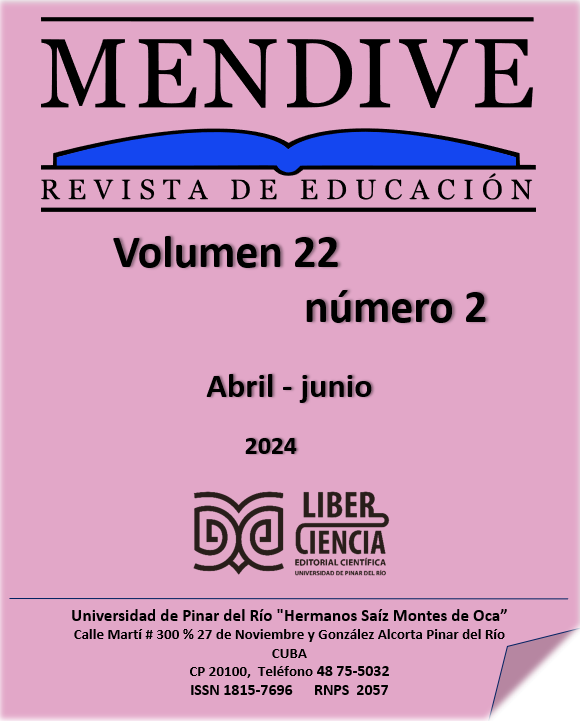Mobile devices as didactic mediators in the teaching of statistics
Main Article Content
Abstract
The use of didactic mediators was of vital importance to optimize work in classes and in this way guarantee learning in Higher Education students. In the case of Statistics, to easily operate these didactic mediators using mobile devices since their applications provide a good opportunity to show students their usefulness by quickly working on application exercises for the different contents, which is why this article was intended The objective is to present and socialize a methodological procedure for teaching Statistics through the use of mobile devices as didactic mediators. Theoretical level methods such as synthetic analytical, historical and logical methods were used. At the empirical level, document review, interviews, performance observation, pedagogical testing and expert consultation were used. As a sample, students from the Agricultural Engineering program at the University of Ciego de Ávila were part of this research. This result can be generalized to other university courses. With the application of this methodological procedure, it was possible to improve student learning in the contents of this discipline.
Downloads
Article Details

This work is licensed under a Creative Commons Attribution-NonCommercial 4.0 International License.
References
Castillo Riquelme, V. (2020). Enseñanza de la estadística inferencial mediante una aplicación móvil. Revista latinoamericana de investigación en matemática educativa, 23(2), 233-258. https://doi.org/10.14482/INDES.30.1.303.661
Coll Salvador, C. (1991). Aprendizaje escolar y construcción del conocimiento. Editorial Piado. Barcelona. España.
Chérrez Ibarra, R.X, Párraga Vera, C.L. y Escalona Reyes, M. (2021). El uso del tic en la enseñanza de la matemática superior, el caso de los dispositivos móviles. Revista Tecnología Educativa, 8(2), 18-29. https://tecedu.uho.edu.cu/index.php/tecedu/article/view/294
Dávila Morán, R.C, Pasquel Cajas, A.F, Castro Cayllahua, F, López Coz, K.R. y Huamán Ccanto, F. (2022). Empleo de teléfonos inteligentes como estrategia de aprendizaje en estudiantes de pregrado en tiempos de crisis sanitaria por covid-19. Revista Conrado 18(S3), 138-147. https://conrado.ucf.edu.cu/index.php/conrado/article/view/2646
Giler Velázquez, L.E. (2020). Estrategias de enseñanza de la matemática en la formación de profesionales de la ingeniería. Dominio de las Ciencias, 6(3), 273-285. https://dominiodelasciencias.com/ojs/index.php/es/article/view/1397/2486
Kim J., y Park H. (2019). Efects of Smartphone-Based Mobile Learning in Nursing Education: A Systematic Review and Meta-analysis. Asian Nursing Research, 13(1), 20-29. https://doi.org/10.1016/j.anr.2019.01.005
López Carcache, A. (2022). Dispositivos móviles como estrategia educativa en la universidad pública en modalidad presencial desde la experiencia de estudiantes y profesores de grado. Revista Torreón Universitario, 11(30), https://revistatorreonuniversitario.unan.edu.ni/index.php/torreon/article/view/403
Osorio Arrascue, E.D, Malpartida Gutiérrez, J.N, Ávila Morales, H. y Valenzuela Muñoz, A. (2021). Aplicaciones móviles: incorporación en procesos de enseñanza en tiempos de covid-19. Revista Venezolana de Gerencia (RVG), 26(93), 65-77. doi: https://doi.org/10.52080/rvg93.06
Rangel Romero, M.A, Santoyo Téllez, F. e Iñiguez Carrillo, A.L. (2019). El uso de App en dispositivos móviles para el aprendizaje de la estadística en el nivel superior. Revista Electrónica sobre Cuerpos Académicos y Grupos de Investigación, 6(12). https://www.cagi.org.mx/index.php/CAGI/article/view/205
Rodríguez Zambrano, A, Rocío Rey, E, Zambrano Cedeño, V. y Rodríguez Arieta, G. (2019). Tics y aplicaciones móviles en la educación superior; del dicho al reto. Revista Atlante: Cuadernos de Educación y Desarrollo (enero 2019). En línea: https://www.eumed.net/rev/atlante/2019/01/tics-educacion-superior.html
Rojas Sandoval, A, Díaz Quintanilla, C.L, García Valero, M.A. y Pérez Rodríguez, A.F. (2023). La enseñanza de la estadística en la Educación Primaria en Cuba. Antecedentes y actualidad (Ensayo). Revista Roca, 19(1), 46-59. http://portal.amelica.org/ameli/journal/440/4403729012/html/
Sánchez Calero, C. (2019). La llegada de las nuevas tecnologías de la educación y sus implicaciones. International Journal of New Education, (4). https://doi.org/10.24310/IJNE2.2.2019.7449
Santana Machado, A.T, Santana Rodríguez, L, Artiles González, P.M. y Matos Ojeda, J.L. (2022). Aplicación móvil para la enseñanza de Bioestadística en las ciencias médicas. (Ponencia). Convención Internacional de Salud. Cuba Salud 2022.
Silvestre Oramas, M. (2000). ¿Cómo hacer más eficiente el aprendizaje? Ediciones CEIDE. México.
Terán Acosta, G, Oña Gamboa, V, Cobos Velasco, J.C. y Miniguano Miniguano, D. (2019). Incidencia de dispositivos móviles en la educación en el Ecuador. Ciencia Digital, 3(3.4), 60-74. https://cienciadigital.org/revistacienciadigital2/index.php/CienciaDigital/article/view/835


